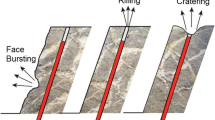Abstract
Due to a potential to cause damage to machinery and structures and cause injuries to personnel, flyrock is the most dangerous adverse effect of blasting operations. Because of that, it is of primary importance to predict flyrock events and maximum range of flyrock fragments in order to define safety limits and secure the perimeter. There are various models for flyrock range prediction, and most of them rely on proper calculations of flyrock launch velocity. However, a unique and universally applicable model of launch velocity prediction still does not exist. Work presented in this article is a concept of adaptive system application for the prediction of flyrock launch velocities. It shows the principles of input data selection, acquisition and processing and presents the principles of design, training, validation and verification of applied artificial neural network.








Similar content being viewed by others
References
Stojadinovic S, Pantovic R, Zikic M (2011) Prediction of flyrock trajectories for forensic applications using ballistic flight equations. Int J Rock Mech Min Sci 48(7):1086–1094
Davies P (1995) Risk-based approach to setting of flyrock ‘danger zones’ for blast sites. Trans Inst Min Metall Min Technol 104:A96–A100
Little TN (2007) Flyrock risk. In: Proceedings EXPLO 2007, September 3–4. Wollongong, NSW, pp 35–43
Raina AK, Chakraborty AK, More R, Choudhury PB (2007) Design of factor of safety based criterion for control of flyrock/throw and optimum fragmentation. J Inst Eng India 87:13–17
Raina AK, Chakraborty AK, Choudhury PB, Sinha A (2011) Flyrock danger zone demarcation in opencast mines: a risk based approach. Bull Eng Geol Environ 70:163–172
Moore AJ, Richards AB (2005) Golden pike cut-back flyrock control and calibration of a predictive model, prepared for Kalgoorlie consolidated gold mines. http://www.superpit.com.au/Portals/0/docs/aboutKcgm/publications/project_and_plans/pdf/Terrock_Golden_Pike_Flyrock_Modelling_Report_464.pdf. Accessed 14 Dec 2014
Richards AB, Moore AJ (2004) Flyrock control—by chance or design. In: Proceedings, 30th annual conference on explosives and blasting technique, 1, February 1–4. New Orleans, Louisiana, pp 335–348
Workman JL, Calder PN (1994) Flyrock prediction and control in surface mine blasting. In: Proceedings 20th annual conference on explosives and blasting technique. The International Society of Explosives Engineers, Austin, pp 59–74
Lundborg N (1981) The probability of flyrock. Report DS. 1981:5, Swedish Detonic Research Foundation, Stockholm
St George JD, Gibson MFL (2001) Estimation of flyrock travel distances: a probabilistic approach. In: Proceedings EXPLO 2001, October 28–31. AusIMM, Melbourne, pp 245–248
Amini H, Gholami R, Monjezi M, Torabi SR, Zadhesh J (2012) Evaluation of flyrock phenomenon due to blasting operation by support vector machine. Neural Comput Appl 21:2077–2085
Monjezi M, Amini H, Varjani AY (2012) Prediction of flyrock and back break in open pit blasting operation: a neuro-genetic approach. Arab J Geosci 5:441–448
Monjezi M, Bahrami A, Varjani AY, Sayadi AR (2011) Prediction and controlling of flyrock in blasting operation using artificial neural network. Arab J Geosci 4:421–425
Bauer A, Burchell SL, Crosby WA (1983) Use of high speed photography in open pit blasting. Mining Resource Engineering Ltd, Kingston
Pantovic R, Zikic M, Stojadinovic S (2007) A study on flyrock causes during blasting on Kamenica quarry. Investigation report, Technical faculty in Bor (original title in Serbian - Studija o uzrocima razletanja kamenih komada pri miniranju na PK Kamenica), Bor
Stojadinovic S, Lilic N, Pantovic R, Zikic M, Denic M, Cokorilo V, Svrkota I, Petrovic D (2013) A new model for determining flyrock drag coefficient. Int J Rock Mech Min Sci 62:68–73
Stojadinovic S, Lilic N, Denic M, Zikic M (2013) Application of an adaptive system to predict blasting flyrock events. In: Proceedings, the 45th international october conference on mining and metallurgy, October 16–19. Bor Lake, Serbia, pp 660–663
Author information
Authors and Affiliations
Corresponding author
Rights and permissions
About this article
Cite this article
Stojadinović, S., Lilić, N., Obradović, I. et al. Prediction of flyrock launch velocity using artificial neural networks. Neural Comput & Applic 27, 515–524 (2016). https://doi.org/10.1007/s00521-015-1872-5
Received:
Accepted:
Published:
Issue Date:
DOI: https://doi.org/10.1007/s00521-015-1872-5




